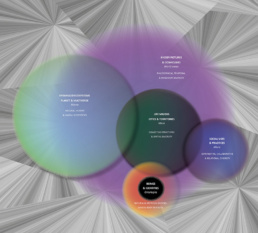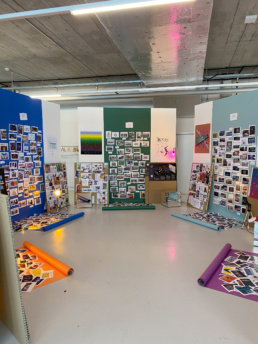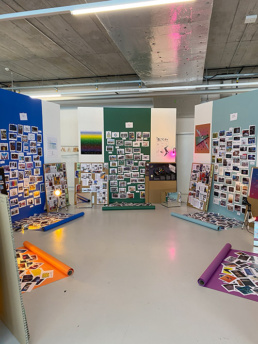Collaborations
Foresight methodological research and innovation
Foresight, i.e. the art and not the science of exploring futures, is a peri-academic discipline – sometimes practiced in universities but more often outside – that has been developing various methodologies since the 1950s, each with its own benefits and limits. Historically attached to Western modernity, the discipline was originally created simultaneously in Europe and the US to support decision-making, strategy, risk management, innovation, planning and policy-making, and remains very marked by this both systemic and pragmatic orientation.
The field is today in evolution – be it to better address the current and unprecedented future challenges, to do so in a more inclusive, collective or concrete manner, or to bring this form of research into new areas. Education, transdisciplinary research, culture, museums, soft power, media, creative and digital industries, events, civic life, consultation, territorial resilience, sustainable development, etc. are all sectors where the exploration of plural futures is increasingly necessary and implemented.
TAC Future Lab is part of this movement of foresight innovation and seeks to design methods and experiments that are open, fluid, creative and educational, rethinking future research and ultimately making it more accessible, fertile, purposeful and efficient.
Foresight methodological research and innovation

Foresight, i.e. the art and not the science of exploring futures, is a peri-academic discipline – sometimes practiced in universities but more often outside – that has been developing various methodologies since the 1950s, each with its own benefits and limits. Historically attached to Western modernity, the discipline was originally created simultaneously in Europe and the US to support decision-making, strategy, risk management, innovation, planning and policy-making, and remains very marked by this both systemic and pragmatic orientation.
The field is today in evolution – be it to better address the current and unprecedented future challenges, to do so in a more inclusive, collective or concrete manner, or to bring this form of research into new areas. Education, transdisciplinary research, culture, museums, soft power, media, creative and digital industries, events, civic life, consultation, territorial resilience, sustainable development, etc. are all sectors where the exploration of plural futures is increasingly necessary and implemented.
TAC Future Lab is part of this movement of foresight innovation and seeks to design methods and experiments that are open, fluid, creative and educational, rethinking future research and ultimately making it more accessible, fertile, purposeful and efficient.

Polygonal research devices and methodological diagram
Continuously investigating and learning from the field of Foresight and other domains (design, art, anthropology, philosophy, world-building, game design, staging, pedagogy, etc.), we design highly fluid methodologies and exploratory devices aimed at a diversity of contexts: educational and/or research programs, cultural venues, events, exhibitions, publications, online, etc.
A key tool in the lab is the TAC Future Canvas (above), a conceptual diagram that allows to structure a prospective exploration at different scales and perspectives, i.e. what we call polygonal research (as multi-faceted / multi-angled). Used in many ways and re-customized through experimentations (on-going design research – see the Research Journal), the diagram serves to structure the future horizon into 5 spheres/scales of exploration and transformation, to map current trends, sort information, position future hypothesis, and design possible future worlds. Its open background allows to situate and envision a diversity of perspectives, which can be temporal (near vs far futures), theoretical (disciplines, approaches, vocabularies), or cultural and including the viewpoints of human and non-human stakeholders.
Workshops and collaborative research modules are supported by exploration kits and eventually supported by online tools such as prepared collaborative documents, shared workspaces and templates.
Other more artistic devices, such as performative installations (left), can be imagined for staged workshops, or exhibitions – see for instance the TAC Installation prototype at HiFlow, Geneva.
Polygonal research devices and methodological diagram

Continuously investigating and learning from the field of Foresight and other domains (design, art, anthropology, philosophy, world-building, game design, staging, pedagogy, etc.), we design highly fluid methodologies and exploratory devices aimed at a diversity of contexts: educational and/or research programs, cultural venues, events, exhibitions, publications, online, etc.
A key tool in the lab is the TAC Future Canvas (above), a conceptual diagram that allows to structure a prospective exploration at different scales and perspectives, i.e. what we call polygonal research (as multi-faceted / multi-angled). Used in many ways and re-customized through experimentations (on-going design research – see the Research Journal), the diagram serves to structure the future horizon into 5 spheres/scales of exploration and transformation, to map current trends, sort information, position future hypothesis, and design possible future worlds. Its open background allows to situate and envision a diversity of perspectives, which can be temporal (near vs far futures), theoretical (disciplines, approaches, vocabularies), or cultural and including the viewpoints of human and non-human stakeholders.
Workshops and collaborative research modules are supported by exploration kits and eventually supported by online tools such as prepared collaborative documents, shared workspaces and templates.
Other more artistic devices, such as performative installations (left), can be imagined for staged workshops, or exhibitions – see for instance the TAC Installation prototype at HiFlow, Geneva.
Collaborative exploration modules
Below are possible collaborative research modules, but our approach will always start by looking at the context, local resources, the profiles and number of participants, and the desired impacts, prior to designing an experiment. These modules can be complementary to other prospective approaches.
M1 · Bigger Picture, masterclass (1-2h)
In this masterclass (30-45mn of presentation followed or interspersed with discussion time), Raphaële Bidault-Waddington shares insights on current transitions, paradigm shifts (global changes), related future challenges, and the ‘future(s)’ as a research object.
This module allows to open the horizon of the future and can also be used to illuminate and map critical future challenges specific to a field, for example as an introduction to a workshop cycle. See for instance our experience with the Geneva Museum of Art and History.
Another good introductory masterclass is a review of the diversity of future research approaches (Foresight, Design, Science-Fiction, Art, Innovation, Resilience) to understand the various potentials.
M2 · The Future Belongs to Everyone, workshop (2-4 h):
This workshop offers a first dive into the future, to experience the immensity of both its challenges and creative potentials, and to appropriate a few key reference points and methodological tools such as the TAC Future Canvas with a view to begin exploring them.
This short module allows the questioning of dominant discourses on the future, taking a step back from them to regain critical autonomy, imagination, and agency. It can integrate more or less daring experiential and creative sequences.
It can also be scheduled following a masterclass (module 1), or serve to re-envision, re-articulate, and give new meaning to existing future research elements (scenarios, trend analysis, prototypes, artistic productions, etc.). See for instance our exploratory day at Louvre Lens Valley.
M3 · Future Worlds, workshop cycle or research program:
This module of in-depth exploration and co-design of visions of the future can be implemented in different contexts, academic or not, such as an educational program (30 hours), via a transdisciplinary research group, or a working group dedicated to a specific critical future topic.
It includes workshops but also collective productions and other formats. Depending on the ins and outs, the profiles involved, the required impacts and publicity, or the work site potentials, we will tailor an exploratory program and devices, which could include expert intervention, online investigation, image-based research, creative experiments and formats, etc. The result can be used and shared in many ways – published, exhibited, or even staged.
This cycle can also be used to support a co-creation process, for example the design of an event, an exhibition, a play or a film. See for instance our collaboration with CNRS for their 80th anniversary.
M4 · Futurescape, installation, device, dedicated space or exhibition:
This artistic and spatialized module taking the shape of an ephemeral staging or an installation can be part or result of a workshop cycle, or be designed for an exhibition or an event. See for instance our exhibition at HiFlow, Geneva, and at Anticipated Worlds Festival, Paris.
This spatialized format, when activated as a research device, such as in the framework of a research program or a pedagogic experiment, strongly facilitates collective exploration, while making it more visible, engaging, and shareable. See for instance our experiment on ISC Paris Campus. It allows deep work on the sensitive, spatial and aesthetic relationship with the future, to use artistic levers to navigate its complexity and open disruptive hypothesis and exploration tracks, and use the space to stage interactions and share points of view.
Depending on the context, orientation and available budget, a futurescape can be designed as an ephemeral or permanent physical space, eventually augmented digitally to become hybrid, or be fully virtualized.
M1 · Bigger Picture, masterclass (1-2h)
In this masterclass (30-45mn of presentation followed or interspersed with discussion time), Raphaële Bidault-Waddington shares insights on current transitions, paradigm shifts (global changes), related future challenges, and the ‘future(s)’ as a research object.
This module allows to open the horizon of the future and can also be used to illuminate and map critical future challenges specific to a field, for example as an introduction to a workshop cycle. See for instance our experience with the Geneva Museum of Art and History.
Another good introductory masterclass is a review of the diversity of future research approaches (Foresight, Design, Science-Fiction, Art, Innovation, Resilience) to understand the various potentials.
M2 · The Future Belongs to Everyone, workshop (2-4 h):
This workshop offers a first dive into the future, to experience the immensity of both its challenges and creative potentials, and to appropriate a few key reference points and methodological tools such as the TAC Future Canvas with a view to begin exploring them.
This short module allows the questioning of dominant discourses on the future, taking a step back from them to regain critical autonomy, imagination, and agency. It can integrate more or less daring experiential and creative sequences.
It can also be scheduled following a masterclass (module 1), or serve to re-envision, rearticulate, and give new meaning to existing future research elements (scenarios, trend analysis, prototypes, artistic productions, etc.). See for instance our exploratory day at Louvre Lens Valley. See for instance our exploratory day at Louvre Lens Valley.
M3 · Future Worlds, workshop cycle or research program:
This module of in-depth exploration and co-design of visions of the future can be implemented in different contexts, academic or not, such as an educational program (30 hours), via a transdisciplinary research group, or a working group dedicated to a specific critical future topic.
It will include workshops but also collective productions and other formats. Depending on the ins and outs, the profiles involved, the required impacts and publicity, or the work site potentials, we will tailor an exploratory program and devices, which could include expert intervention, online investigation, image-based research, creative experiments and formats, etc. The result can be used and shared in many ways – published, exhibited, or even staged.
This cycle can also be used to support a co-creation process, for example the design of an event, an exhibition, a play or a film. See for instance our collaboration with CNRS for their 80th anniversary.
M4 · Futurescape, installation, device, dedicated space or exhibition:
This artistic and spatialized module taking the shape of an ephemeral staging or an installation can be part or result of a workshop cycle, or be designed for an exhibition or an event. See for instance our exhibition at HiFlow, Geneva, and at Anticipated Worlds Festival, Paris.
This spatialized format, when activated as a research device, such as in the framework of a research program or a pedagogic experiment, strongly facilitates collective exploration, while making it more visible, engaging, and shareable. See for instance our experiment on ISC Paris Campus. It allows deep work on the sensitive, spatial and aesthetic relationship with the future, to use artistic levers to navigate its complexity and open disruptive hypothesis and exploration tracks, and use the space to stage interactions and share points of view.
Depending on the context, orientation and available budget, a futurescape can be designed as an ephemeral or permanent physical space, eventually augmented digitally to become hybrid, or be fully virtualized.